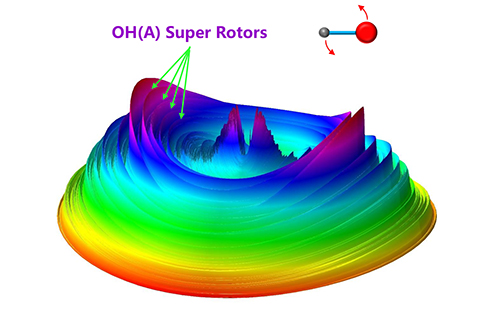The superexcited molecule plays an important role as a reaction intermediate. The presence of high-energy radiation fields in the universe yields various superexcited molecules.
Understanding the fragmentation processes of the superexcited molecule is important in the upper atmosphere of the planets and in the photodissociation region (PDR) of the planetary nebula. However, the investigation of such processes is challenging due to the lack of energetic photons in a lab that excite the molecules to the extremely high-lying excited states.
With the advent of the intense, pulsed free-electron laser (FEL) in Dalian Coherent Light Source (DCLS) at Dalian, China, the photofragment study of molecules and radicals has become feasible for vacuum-ultraviolet (VUV) wavelengths below 100 nm using the high resolution translational energy spectroscopy.
Recently, Prof. YUAN Kaijun and Prof. YANG Xueming's group from the Dalian Institute of Chemical Physics (DICP) of the Chinese Academy of Sciences, in collaboration with Prof. HU Xixi and Prof. XIE Daiqian from Nanjing University, revealed the electronically excited OH super-rotors in water photochemistry, for the first time.
This study was published in Journal of Physical Chemistry Letters on August 24.

The 3D product contour diagram from the photodissociation of H2O at 96.4nm (Image by CHANG Yao)
"We used VUV-FEL laser pulses with the wavelength of 96.4 nm to excite the water molecule to a high Rydberg state with the energy above its ionization potential, and then the H atom produced in the fragmentation of this superexcited water molecule was detected using HRTOF technique," said Prof. YUAN.
The experimental results indicated that the binary fragmentation channels H + OH and the triple channels O + 2H both present at 96.4 nm photolysis. Electronically excited OH super-rotors, with the internal energy just above the OH (A) dissociation energy, were observed for the first time, which were only supported by the large centrifugal barriers. The lifetime of these electronically excited OH super-rotors depended on the tunneling effect and predissociation effect.
"We recalculated the potential energy curves of OH, and found that even though the N = 36 pure rotational level of OH was already above its dissociation limit, the tunneling lifetime of this state through the centrifugal barrier was quite long (>2 year). However, the crossings of the ro-vibrational levels with the repulsive states caused severe predissociation," said Prof. HU.
The predissociation rate was several orders magnitude faster than the tunneling rate. As a result, the lifetimes of the OH super-rotors were around 370-57 ps. This suggests that these electronically excited super-rotors identified in the present work might have a role in the subsequent chemical reactions in the dense atmosphere.
This study was supported by the National Natural Science Foundation of China, the Strategic Priority Research Program of the Chinese Academy of Sciences, the Chemical Dynamics Research Center, the international partnership program of Chinese Academy of Sciences, and the Key Technology Team of the Chinese Academy of Sciences. The theoretical work was supported by NSFC. (Text by CHANG Yao)